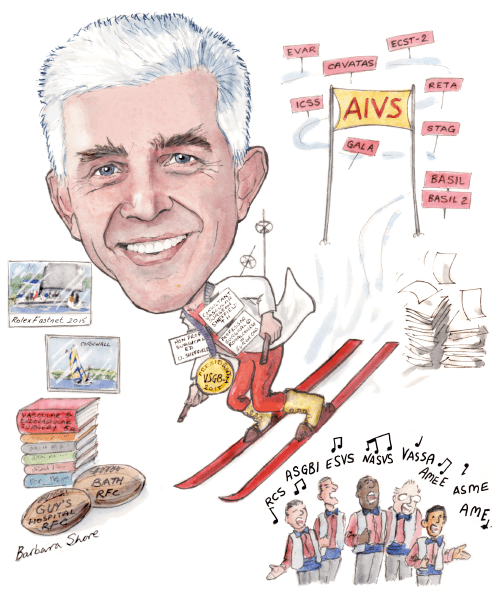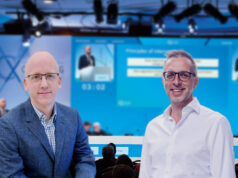
Although he initially planned to become an electronic engineer like his father, Jonathan Beard, Sheffield Vascular Institute, The Northern General Hospital, Sheffield, UK, was persuaded to enter the medical profession. Jonathan’s research interests include supervised exercise programmes for patients with intermittent claudication and revascularisation strategies for the treatment of critical limb ischaemia. He spoke to Vascular News about what he has learned during his career so far, the current and future medical advances he is most excited about and his active lifestyle outside of his work.
Why did you decide you wanted a career in medicine, and why in particular did you choose to enter the vascular field?
I actually wanted to be an electronic engineer like my Dad, but he persuaded me that medicine was a better option. Guy’s Hospital in London, where I trained as a medical student, had a well-known Medical Engineering Department, and so I opted for an intercalated degree in physics applied to medicine. My supervisor was Dr Ray Gosling, who had a great interest in haemodynamics, and my BSc was on Fourier analysis of Doppler ultrasound blood flow waveforms. A career in vascular surgery seemed an obvious choice and my subsequent Masters, at the University of Bristol, focussed on blood flow measurement.
Who have been your career mentors and what wisdom did they impart?
I was lucky to work for John Fairgrieve at Cheltenham Hospital who was one of the first surgeons in the UK to undertake vascular surgery. He had taken himself off to France in the 1970s to learn about in situ vein bypass, and was very proud of his Cartier valvulotomes. He was a very patient teacher and I learned from him that surgical trainees can take on difficult procedures at an early stage, if well supervised. I then worked with two other well-known vascular surgeons, Mike Horrocks in Bristol and Peter Bell in Leicester. They were both involved with the European Society for Vascular Surgery (ESVS), and that is how I became involved with the ESVS and the European Journal of Vascular and Endovascular Surgery (EJVES).
What have been the biggest developments in vascular medicine during the course of your career?
The biggest developments in vascular medicine have been the development of statins, more effective antiplatelet and antihypertensive agents, and more effective smoking cessation strategies. These have had a dramatic impact on the incidence of adverse vascular events. Vascular surgeons need to be experts in vascular medicine and risk-factor modification. It is a fact of life that many more patients with vascular disease benefit from tablets than the few who benefit from intervention.
What are some of the proudest moments in your career?
The publication of the first edition of Vascular and Endovascular Surgery, which has become a standard textbook for many vascular surgery trainees and is now on its 5th edition, was one of my proudest moments. Another was my appointment as Editor of the EJVES and being responsible for increasing its readership, impact factor and profitability. Being appointed as President of the Vascular Society of Great Britain and Ireland was a great honour and responsibility. My current role as Professor of Surgical Education at the Royal College of Surgeons has allowed me to influence the future of surgical training in the UK, and more widely through the International Conference on Surgical Education (ICOSET), which I organised in 2014.
What new vascular technology are you watching closely and why?
The holy grail of vascular technology is a non-thrombogenic small calibre graft or stent graft that can be used for infrainguinal bypass grafting or stenting, especially when no vein is available. I have seen so many developments come and go, including endothelial cell seeding, heparin bonding, and new biomaterials, but so far none has fulfilled its initial promise.
What is the most interesting paper or presentation that you have seen recently?
I presume you mean apart from my own, and those from my current and previous trainees! I think most major vascular journals and meetings tend to focus rather too much on new technology, much of which is unproven. I understand the financial drivers behind this, but most patients with vascular disease will not benefit from this technology, especially in middle- and low-income countries. I heard a fascinating presentation from a trauma surgeon from Canada who, through the clever use of health advocacy and patient involvement, had persuaded the Government to ban people from riding in the back of pickup trucks. This simple measure has saved thousands of lives, in contrast to the few hundred that he had personally saved whilst doing his day-job.
You advocate the adoption of supervised exercise programmes (SEPs) for peripheral arterial disease patients. What are the challenges to the adoption of nationwide SEPs?
There is level 1 evidence that SEPs are more cost-effective than revascularisation, and NICE guidance states that they should be the first-line treatment for claudicants. There is also good evidence that exercise programmes can help with national targets for reducing the levels of obesity and diabetes. Despite this evidence, less than 20% of patients in the UK and Europe have access to such a programme. The barriers include lack of promotion by vascular surgeons, most of whom prefer operating; lack of support from industry, who see no profit in it; and lack of enthusiasm from patients, who want a quick fix. We need a change of culture amongst vascular surgeons to emphasise the importance of physical therapy and health advocacy.
The jury is still out about the best revascularisation strategy for the treatment of critical limb ischaemia. How will the new trials in the USA and Europe help shed light on this topic?
Following the success of BASIL 1, I am very pleased that Andrew Bradbury got the funding for BASIL 2, and hopefully 3. Unfortunately, funding for such multicentre randomised controlled trials is very tight and many industry-sponsored trials are too small to produce any meaningful evidence. Yet the surgeons and companies involved heavily promote any “good results”, in the hope that the technique or product will be adopted.

You follow vascular surgery fellowship and training programmes closely. What advice would you give to young vascular surgeons starting out in their careers?
How should a young surgeon reconcile open and endovascular skills? My advice to those wishing to pursue a career in vascular surgery is that the future is in medicine not surgery! Most surgeons of the future will be “physicians who operate”. Therefore, you need to be happy with that scenario and ensure that you obtain a good grounding in vascular medicine and duplex ultrasound. It is likely that the vascular surgeon of the future will be credentialed to perform a limited number of procedures, as has happened in orthopaedic surgery. The key to providing a comprehensive service is for vascular surgeons to work in large teams using a hub and spoke model. This ensures good local access to care, with major endovascular or open procedures being performed at the hub hospital.
Could you tell us about one of your most memorable cases? What did this experience teach you?
My most memorable cases are usually when things have gone wrong. These are the cases that you can learn from most through a process of personal reflection and discussion with colleagues. While this process needs to be encouraged, it does not always prevent patient harm. Other high-risk industries like aviation use simulation and team training to avoid problems occurring in the first place. Surgery needs to learn from them—patients find it unbelievable that theatre team training, including the use of simulated scenarios, is not mandatory for all theatre staff, including surgeons. The main thing I have learned is that there is no shame in calling for help, no matter how senior or experienced you are.
What are some of your hobbies and interests outside of medicine?
Most of my hobbies are in the picture! I spent much of my undergraduate training playing rugby and water polo. My interview for medical school was classic: “You are a tall chap—we need a second row”! After qualifying, I moved to the West Country to play rugby for Bath RFC, which is why I ended up working at Cheltenham. I am a keen skier, as are my wife Clare and children, and they are always eager to accompany me to the annual meeting of the Association of International Vascular Surgeons. My other passion from childhood is sailing. I currently crew for Andrew McIrvine’s First 40 La Réponse and we competed in the Rolex Fastnet Race in 2015. My own boat is a Dart 16 catamaran, which I keep on the Camel Estuary in North Cornwall. This boat is very fast and can pitch-pole quite spectacularly—most of my family have bruises and scars to show for it. I discovered barbershop (close-harmony acapella singing) when I arrived in Sheffield. I was blown away by the sound, and have since won 5 gold medals with the Sheffield chorus Hallmark of Harmony. We won the national championship in 2014 and competed at the international competition in the USA in 2015.
Fact File
Medical education (selected):
1973–1979 Guy’s Hospital, London
1976 BSc (1st Class Hons, University of London)
1979 MB BS (Guy’s Hospital, London)
1984 FRCS (England)
1987 ChM (University of Bristol)
2004 MEd (University of Sheffield)
2011 FRCS ad hominem (Edinburgh)
Current appointments (selected):
1990 Consultant Vascular Surgeon, Sheffield Teaching Hospitals
2007 Honorary Professor of Surgical Education, University of Sheffield
2012 Professor of Surgical Education, Royal College of Surgeons of England
Previous clinical appointments (selected):
1979–1980 House Officer, Guy’s and Lewisham Hospitals, London
1981–1982 Casualty Officer and Anatomy Demonstrator, Middlesex Hospital, London
1982–1983 General Surgical SHO, Brighton General and Royal Sussex County Hospital
1982–1984 General Surgical Registrar, Cheltenham General Hospital
1984–1986 Vascular Research Fellow, Bristol Royal Infirmary
1986–1988 General Surgical Registrar, Frenchay Hospital and the Bristol Royal Infirmary
Previous academic appointments (selected):
1992–1998 Education Tutor, Royal College of Surgeons of England
1988–1990 Lecturer in Surgery, University of Leicester
Society and journal appointments (selected):
1992–1998 Associate Editor, European Journal of Vascular and Endovascular Surgery
1998–2004 Senior Editor, European Journal of Vascular and Endovascular Surgery
2005–2008 Editor-in-Chief, European Journal of Vascular and Endovascular Surgery













